
 Priyesh Ghamandi
Priyesh Ghamandi
In today’s globalized economy, businesses must cater to diverse markets with varying economic conditions, purchasing power, and competitive landscapes. One pricing strategy that addresses this challenge effectively is geographical pricing. This approach allows companies to adjust their prices based on the location of their customers, ensuring they remain competitive while optimizing revenue. In this blog, we'll delve into what geographical pricing entails, how to create a strategy, and real-world examples of its implementation.
Geographical pricing is a pricing strategy where businesses set different prices for their products or services depending on the customer's location. This method takes into account factors such as:
Geographical Pricing Strategy is a pricing approach where businesses adjust their product or service prices based on the customer's location. This strategy takes into account various factors such as local economic conditions, purchasing power, logistical costs, market competition, and regional taxes or tariffs. It helps businesses align their pricing with the realities of specific markets, making products more accessible and competitive in diverse regions. By tailoring prices to suit local conditions, businesses can expand into new markets, optimize revenue, and enhance customer satisfaction. This strategy is particularly useful for global and multi-regional companies looking to balance affordability with profitability while staying competitive in geographically distinct markets.
Read our comprehensive guide to learn how to build effective geographical pricing strategies.
Airlines frequently use geographical pricing based on the departure and destination locations. For instance, tickets for the same flight may cost differently when booked from different countries due to varying demand and competition.
Platforms like Netflix and Spotify offer subscription plans at varying prices based on the customer’s country. In regions with lower income levels, the subscriptions are often more affordable.
E-commerce giants like Amazon adjust product prices and shipping costs based on the customer's location. For example, products shipped to remote areas may include higher delivery fees.
SaaS businesses, such as HubSpot and DealSavvy, often use geographical pricing to attract customers in emerging markets by offering region-specific discounts. This approach enables them to penetrate price-sensitive markets effectively.
Global retail brands like Zara or IKEA may adjust prices based on the local economic environment. Prices in Europe may differ significantly from those in Asia due to production and operational costs.
Learn how geographical pricing can be a game-changer for retail and e-commerce businesses
While geographical pricing offers numerous advantages, it also comes with challenges:
Read our article on how to overcome challenges in geographical pricing.
Geographical pricing is a powerful strategy that allows businesses to navigate the complexities of global markets. By tailoring prices based on economic conditions, customer behavior, and logistical costs, companies can optimize revenue while remaining competitive and customer-friendly. Whether you're an e-commerce retailer, SaaS provider, or global brand, implementing a thoughtful geographical pricing strategy can unlock new opportunities and foster growth in diverse markets.
Are you considering geographical pricing for your business? Tools like DealSavvy can help you take the guesswork out of location-based pricing, allowing you to cater to customers across the globe effectively.
Unlock the power of location-based pricing and grow your global reach.
Learn how to grow your business with our expert advice.

 Priyesh Ghamandi
Priyesh Ghamandi
 Shweta Rathod
Shweta Rathod
 Priyesh Ghamandi
Priyesh Ghamandi